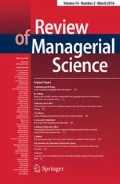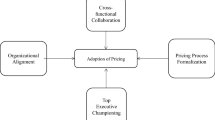Abstract
Partitioned pricing (PP) has received increased attention in both managerial practice and academic literature. The fragmented nature of existing research, terminological and conceptual inconsistencies, and ambiguous findings regarding performance implications of PP underscore the need for an organization of the PP literature. This article provides four major contributions to the literature. First, it develops a new definition of PP based on a critical evaluation of the current body of literature and an analysis of key characteristics of the concept. Second, this article discusses the primary theoretical perspectives used to explain PP, which provides insights into the theoretical foundation of the concept and impetus for future studies on PP. Third, this article presents a review of the state-of-the-art in research on PP and provides managers with guidelines about when and how to apply this pricing tactic. Finally, this article identifies overarching limitations of prior PP research and outlines avenues for further research.

Similar content being viewed by others
References
Albinsson PA, Burman B, Das N (2010) Price surcharge and the effects of construal level. J Appl Bus Econ 11(4):56–69
Ancarani F, Gerstner E, Posselt T, Radic D (2009) Could higher fees lead to lower prices? J Prod Brand Manag 18(4):297–305
Ashenfelter O (1989) How auctions work for wine and art. J Econ Perspect 3(3):23–36
Bambauer S, Gierl H (2008) Should marketers use price partitioning or total prices? In: Lee AY, Soman D (eds) Advances in consumer research (35). Association for Consumer Research, Duluth, MN, pp 262–268
Bambauer-Sachse S, Mangold S (2010) Does a marketer’s responsibility for a surcharge moderate price partitioning effects? In: Campbell MC, Inman J, Pieters R (eds) Advances in consumer research (37). Association for Consumer Research, Duluth, MN, pp 333–339
Bertini M, Wathieu L (2008) Attention arousal through price partitioning. Mark Sci 27(2):236–246
Blanthorne C, Roberts ML (2015) Cognitive responses to partitioned pricing of consumption taxes: consequences for state and local tax revenues. J Am Tax Assoc 37(1):183–204
Brown J, Hossain T, Morgan J (2010) Shrouded attributes and information suppression: evidence from the field. Q J Econ 125(2):859–876
Burman B, Biswas A (2007) Partitioned pricing: can we always divide and prosper? J Retail 83(4):423–436
Cacioppo JT, Petty RE (1982) The need for cognition. J Pers Soc Psychol 42(1):116–131
Carlin BI (2009) Strategic price complexity in retail financial markets. J Financ Econ 91(3):278–287
Carlson JP, Weathers D (2008) Examining differences in consumer reactions to partitioned prices with a variable number of price components. J Bus Res 61(7):724–731
Carrns A (2013) A.T.M. surcharge fees on the rise. http://bucks.blogs.nytimes.com/2013/04/23/a-t-m-surcharge-fees-on-the-rise. Accessed 27 Aug 2015
Chakravarti D, Krish R, Paul P, Srivastava J (2002) Partitioned presentation of multicomponent bundle prices: evaluation, choice and underlying processing effects. J Consum Psychol 12(3):215–229
Chandran S, Morwitz VG (2006) The price of ‘free’-dom: consumer sensitivity to promotions with negative contextual influences. J Consum Res 33(3):384–392
Chatterjee P (2010) Consumer response to promotions in the presence of surcharge: implications for online retailing. J Cust Behav 9(2):117–134
Chatterjee P, McGinnis J (2010) Customized online promotions: moderating effect of promotion type on deal value, perceived fairness, and purchase intent. J Appl Bus Res 26(4):13–20
Cheema A (2008) Surcharges and seller reputation. J Consum Res 35(2):167–177
Chetty R, Looney A, Kroft K (2009) Salience and taxation: theory and evidence. Am Econ Rev 99(4):1145–1177
Chioveanu I, Zhou J (2013) Price competition with consumer confusion. Manag Sci 59(11):2450–2469
Clark JM, Ward SG (2008) Consumer behavior in online auctions: an examination of partitioned prices on eBay. J Mark Theory Pract 16(1):57–66
Colantuoni F, Rojas C (2015) The impact of soda sales taxes on consumption: evidence from scanner data. Contemp Econ Policy 33(4):714–734
Ellison G, Wolitzky A (2012) A search cost model of obfuscation. RAND J Econ 43(3):417–441
Estelami H (2003) The effect of price presentation tactics on consumer evaluation effort of multi-dimensional prices. J Mark Theory Pract 11(1):1–16
Feldman NE, Ruffle BJ (2015) The impact of including, adding and subtracting a tax on demand. Econ Policy 7(1):95–118
Frischmann T, Hinz O, Skiera B (2012) Retailers’ use of shipping cost strategies: free shipping or partitioned prices? Int J Electron Commun 16(3):65–88
Gumus M, Li S, Oh W, Ray S (2013) Shipping fees or shipping free? Impact of product and retailer characteristics on shipping charges in e-commerce. Prod Oper Manag 2(4):758–776
Hamilton RW, Srivastava J (2008) When 2 + 2 is not the same as 1 + 3: variations in price sensitivity across components of partitioned prices. J Mark Res 5(4):450–461
Hamilton RW, Srivastava J, Abraham AT (2010) When should you nickel-and-dime your customers? Mit Sloan Manag Rev 52(1):59–67
Hardesty DM, Bearden WO, Carlson JP (2007) Persuasion knowledge and consumer reactions to pricing tactics. J Retail 83(2):199–210
Hayashi AT, Nakamura BK, Gamage D (2013) Experimental evidence of tax salience and the labor–leisure decision: anchoring, tax aversion, or complexity. Public Finance Rev 41(2):203–226
Higgins ET (1997) Beyond pleasure and pain. Am Psychol 52(12):1280–1300
Homburg C, Totzek D, Krämer M (2014) How price complexity takes its toll: the neglected role of a simplicity bias and fairness in price evaluations. J Bus Res 67(6):1114–1122
Hossain T, Morgan J (2006) …Plus shipping and handling: revenue (non)equivalence in field experiments on eBay. Adv Econ Anal Policy 5(2):1–27
Johnson EJ, Payne JW (1985) Effort and accuracy in choice. Manag Sci 31(4):395–414
Kachersky L, Kim HM (2011) When consumers cope with price-persuasion knowledge: the role of topic knowledge. J Mark Manag 27(1):28–40
Kahneman D, Tversky A (1979) Prospect theory: an analysis of decision under risk. Econometrica 47(2):263–291
Kim HM (2006) The effect of salience on mental accounting: how integration versus segregation of payment influences purchase decisions. J Behav Decis Mak 19(4):381–391
Kim HM, Kachersky L (2006) Dimensions of price salience: a conceptual framework for perceptions of multi-dimensional prices. J Prod Brand Manag 15(2):139–147
Kim HM, Kramer T (2006) The moderating effects of need for cognition and cognitive effort on responses to multi-dimensional prices. Mark Lett 17(3):193–203
Koukova NT, Srivastava J, Steul-Fischer M (2012) The effect of shipping fee structure on consumers’ online evaluations and choice. J Acad Mark Sci 40(6):759–770
Lee YH, Han CY (2002) Partitioned pricing in advertising: effects on brand and retailer attitudes. Mark Lett 13(1):27–40
Lee K, Choi J, Li YJ (2014) Regulatory focus as a predictor of attitudes toward partitioned and combined pricing. J Consum Psychol 24(3):355–362
Lewis M (2006) The effect of shipping fees on customer acquisition, customer retention, and purchase quantities. J Retail 82(1):13–23
Lewis M, Singh V, Fay S (2006) An empirical study of the impact of nonlinear shipping and handling fees on purchase incidence and expenditure decisions. Mark Sci 25(1):51–64
Lynn M, Wang S (2013) The indirect effects of tipping policies on patronage intentions through perceived expensiveness, fairness, and quality. J Econ Psychol 39:62–71
Morwitz VG, Greenleaf EA, Johnson EJ (1998) Divide and prosper: consumers’ reactions to partitioned prices. J Mark Res 35(4):453–463
Muthitacharoen A, Perry JT (2013) Examining effectiveness of partitioned-pricing strategies and its transparency in online auction marketplaces. J Inf Technol Manag 24(4):1–13
Nobel C (2013) Airlines misrepresenting fare surcharges as taxes. http://www.forbes.com/sites/hbsworkingknowledge/2013/02/07/harvard-researchers-airlines-misrepresenting-fare-surcharges-as-taxes. Accessed 27 Aug 2015
Ott RL, Andrus DM (2000) The effect of personal property taxes on consumer vehicle-purchasing decisions: a partitioned price/mental accounting theory analysis. Public Financ Rev 28(2):134–152
Podsakoff PM, MacKenzie SB, Bacharach DG, Podsakoff NP (2005) The influence of management journals in the 1980s and 1990s. Strateg Manage J 26(5):473–488
Reppeti T, Roe S, Gregory A (2015) Pricing strategies for resort fees: consumer preferences favor simplicity. Int J Contemp Hosp 27(5):790–809
Rosenbloom S (2012) Fleeced by fees when you travel? http://www.nytimes.com/2012/09/23/travel/fleeced-by-fees-when-you-travel.html. Accessed 27 Aug 2015
Schindler RM, Maureen M, Bechwati NN (2005) Shipping charges and shipping-charge skepticism: implications for direct marketers’ pricing formats. J Interact Mark 19(1):41–53
Schulz F, Schlereth C, Mazar N, Skiera B (2015) Advance payment systems: paying too much today and being satisfied tomorrow. Int J Res Mark 32(3):238–250
Sheng S, Bao Y, Pan Y (2007) Partitioning or bundling? Perceived fairness of the surcharge makes a difference. Psychol Mark 24(12):1025–1041
Smith R (2012) Increasing use of surcharges on consumer utility bills. http://www.aarp.org/content/dam/aarp/aarp_foundation/2012-06/increasing-use-of-surcharges-on-consumer-utility-bills-aarp.pdf. Accessed 27 Aug 2015
Smith MD, Brynjolfsson E (2001) Consumer decision making at an internet shopbot: brand still matters. J Ind Econ 49(4):541–558
Srivastava J, Chakravarti D (2011) Price presentation effects in purchases involving trade-ins. J Mark Res 48(5):910–919
Thaler RH (1985) Mental accounting and consumer choice. Mark Sci 4(3):199–214
Tuttle B (2012) As airline fees top $36 billion, is relief in sight for fee-weary Travelers? http://www.business.time.com/2012/10/31/as-airline-fees-top-36-billion-is-relief-in-sight-for-fee-weary-travelers. Accessed 27 Aug 2015
Tuzovic S, Simpson M, Kuppelwieser V, Finsterwalder J (2014) From ‘free’ to fee: acceptability of airline ancillary fees and the effects on customer behavior. J Retail Consum Serv 21(2):98–107
Tversky A, Kahneman D (1974) Judgment under uncertainty: heuristics and biases. Science 185:1124–1131
Voelckner F (2008) The dual role of price: decomposing consumers’ reaction to price. J Acad Mark Sci 36(3):359–377
Voelckner F, Ruehle A, Spann M (2012) To divide or not to divide? The impact of partitioned pricing on the informational and sacrifice effects of price. Mark Lett 23(3):719–730
Wang S, Lynn M (2015) The effects of service charges versus service-included pricing on deal perception. J Hosp Tour Res. doi:10.1177/1096348014525636
Weiner B (1986) An attributional theory of motivation and emotion. Springer, New York
Weiner B (2000) Attributional thoughts about consumer behavior. J Consum Res 27(3):382–387
Xia L, Monroe KB (2004) Price partitioning on the internet. J Interact Mark 18(4):63–73
Yadav MS (1994) How buyers evaluate product bundles: a model of anchoring and adjustment. J Consum Res 21(2):342–353
Author information
Authors and Affiliations
Corresponding author
Appendix
Appendix
See Table 5.
Rights and permissions
About this article
Cite this article
Voester, J., Ivens, B. & Leischnig, A. Partitioned pricing: review of the literature and directions for further research. Rev Manag Sci 11, 879–931 (2017). https://doi.org/10.1007/s11846-016-0208-x
Received:
Accepted:
Published:
Issue Date:
DOI: https://doi.org/10.1007/s11846-016-0208-x




